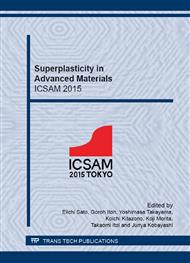p.177
p.183
p.190
p.196
p.202
p.208
p.214
p.220
p.225
Development of Al-Mg Alloys with Different Levels of Mn and Fe for Super-Plastic Forming
Abstract:
New Al-Mg alloys have been developed for super-plastic forming (SPF) based on commercial AA5083/AA5086 alloys, but with an increased Mn content from 0.5 to 1.5 wt.% and a decreased impurity Fe level from 0.25 to 0.05 wt.%.The effects of Mn and Fe levels on super-plasticity have been investigated by high temperature tensile testing of cold rolled H18 sheets at 425 to 525°C with a strain rate of 2×10-3 s-1. The microstructure evolution during different processing stages, grain size and grain size stability were investigated by optical microscopy and scanning electron microscopy. Both Mn and Fe showed a similar and significant contribution to grain size control in recrystallization, but their effect on high temperature sheet formability was different. An increase in Mn level led to an improvement in high temperature tensile elongation, while an increase in Fe content reduced the sheet formability. A new alloy with 1.5 wt.% Mn and 0.05 wt.% Fe, when processed to H18 temper, was able to reach more than 400% tensile elongation at 450 - 500°C with a strain rate of 2×10-3 s-1.
Info:
Periodical:
Pages:
202-207
Citation:
Online since:
January 2016
Authors:
Price:
Сopyright:
© 2016 Trans Tech Publications Ltd. All Rights Reserved
Share:
Citation:


